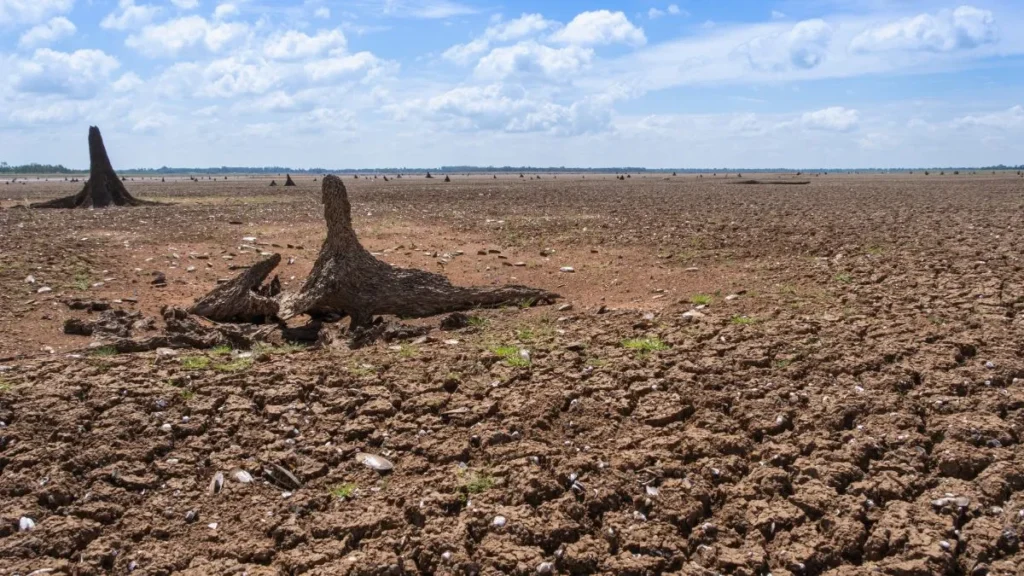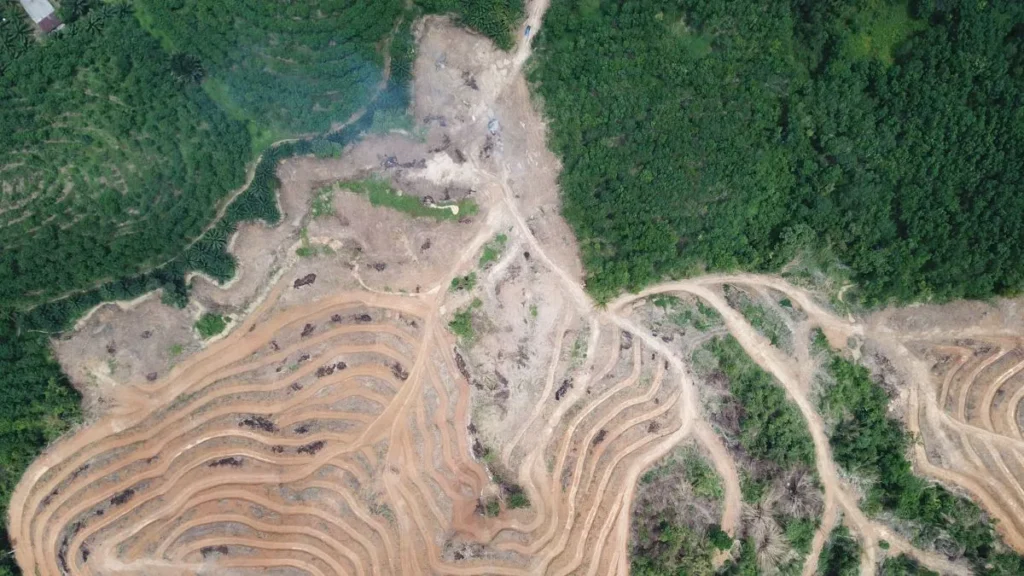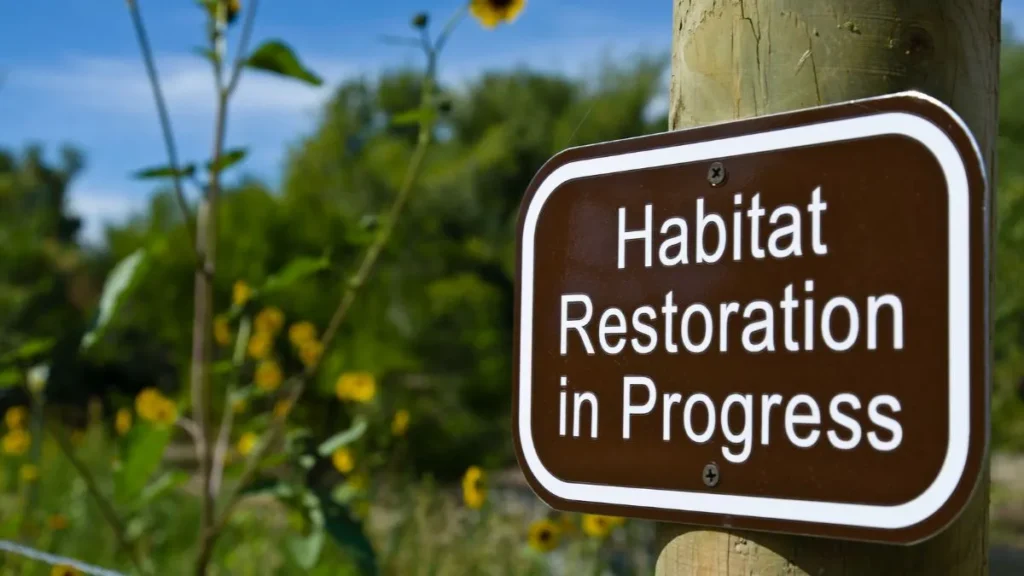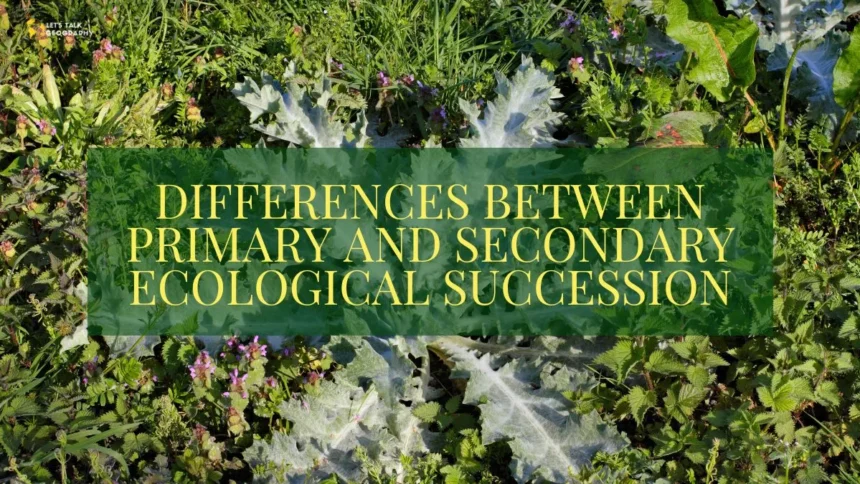Introduction
Have you ever wondered how ecosystems recover after a major disturbance? What processes help forests regrow or how barren land eventually teem with life?
Ecological succession is the fascinating answer to these questions. It’s the process through which ecosystems develop and change over time. But did you know two types of succession—primary and secondary—follow different paths? This ultimate guide will explore the six vital differences between primary and secondary ecological succession and help you understand how ecosystems bounce back after various natural or human-induced changes.
What is Ecological Succession?
Let’s define ecological succession before discussing the differences between primary and secondary ecological succession. It refers to the gradual ecosystem recovery and development process following a disturbance. Ecosystems evolve through predictable stages, whether it’s a volcanic eruption or a wildfire.
Read also: Ecosystem | Definition, Components, and 5 Important Types of Ecosystem
Overview of Primary Ecological Succession
Primary ecological succession is the gradual colonization of barren landscapes. Picture this: a newly formed volcanic island, void of soil or life. Over time, small plants like mosses and lichens colonize the bare rock, slowly breaking it down to form soil. This marks the beginning of primary succession, which can take hundreds, even thousands of years to develop into a mature, thriving ecosystem.
Stages of Primary Ecological Succession:
- Bare rock: After a major disturbance, there’s no soil left.
- Pioneer species: Lichens, mosses, and other hardy species begin to colonize.
- Soil formation: Organic matter builds as these organisms die and decompose.
- Intermediate species: Small plants like grasses and shrubs begin to take root.
- Climax community: The ecosystem is stable with larger plants, trees, and animal life.
Overview of Secondary Ecological Succession
Unlike primary succession, secondary ecological succession occurs in environments where soil is already present. Think of a forest after a fire or abandoned farmland. The major distinction is that the environment isn’t starting from scratch. Secondary succession happens much more quickly because the soil already contains seeds, nutrients, and microbial life.
Stages of Secondary Ecological Succession:
- Disturbance: The ecosystem experiences a disturbance like a fire, flood, or human activity.
- Early colonizers: Fast-growing grasses and weeds begin to cover the ground.
- Shrubs and young trees: Over time, shrubs and young trees replace smaller plants.
- Climax community: Eventually, the ecosystem returns to its former state with mature trees and diverse wildlife.
Differences Between Primary and Secondary Ecological Succession
Now that we’ve outlined both types of ecological succession, let’s move on to the heart of this guide: the differences between primary and secondary ecological succession.
1. Presence of Soil
Primary succession starts on barren land
Think volcanic islands, glacial retreats, or areas left bare by extreme events. There’s no soil at the start, and it must develop over time. In contrast, secondary succession occurs on land with soil, like an abandoned farm or a forest after a fire.
“The absence of soil in primary succession means the process takes longer to establish a thriving ecosystem.”
Key takeaway: Soil is already present in secondary succession, speeding up the process considerably.

2. Initial Colonizers
Pioneer species like lichens and mosses are the first to colonize the area in primary succession. These organisms are uniquely suited to survive in harsh, barren environments, breaking down rock to form soil. On the other hand, in secondary succession, weeds, grasses, and shrubs are the first species to regrow since soil and nutrients are already available.
| Type of Succession | Pioneer Species | Example Ecosystem |
| Primary Succession | Lichens, mosses | Volcanic islands |
| Secondary Succession | Grasses, weeds, shrubs | Abandoned farmland |
3. Speed of Succession
Primary succession is a slow process. Developing enough soil and nutrients to support a complex ecosystem can take centuries. In contrast, secondary succession is much faster since soil and a seed bank are already in place. It may take only a few decades for an ecosystem to return to a climax state after secondary succession begins.
Key takeaway: Primary succession is significantly slower than secondary succession due to the need for soil formation.
4. Type of Disturbance
Another critical difference is the type of disturbance. Primary succession often follows large-scale, rare events like volcanic eruptions or glacial movements without a trace of the previous ecosystem. Secondary succession occurs after more common events like wildfires, floods, or human activities that damage but don’t destroy an ecosystem.
“Primary succession begins where life cannot immediately return; secondary succession happens where life can rebound more quickly.”
5. Climax Community
While primary and secondary succession ultimately leads to a climax community, the species composition may differ. Since primary succession starts from scratch, the species that eventually inhabit the area might be completely different from those that existed before. In secondary succession, the climax community often resembles the pre-disturbance ecosystem, with similar species returning to dominate the landscape.
Key takeaway: Secondary succession tends to restore ecosystems to their original state, whereas primary succession may result in new ecosystems.
6. Human and Natural Interference
Primary succession is less influenced by human activities simply because it occurs in areas often inaccessible or inhospitable (like volcanic islands or glaciers). Secondary succession, however, is frequently influenced by human actions—agriculture, deforestation, and urbanization, all of which can accelerate or alter the natural process.

Key takeaway: Secondary succession is more susceptible to human interference than primary succession.
Read also: Soil Formation Process: 1 Glimpse From Rock to Rich Earth
Significance of Ecological Succession
Understanding the difference between primary and secondary ecological succession is essential for appreciating how ecosystems recover and maintain biodiversity. Both types of succession play a crucial role in the health and restoration of habitats after natural or human-induced disturbances. Here’s why it matters:
Vital for Ecosystem Recovery
- The difference between primary and secondary ecological succession lies in how ecosystems start their recovery. Primary succession begins from a bare rock with no soil, while secondary succession starts with the existing soil. These processes help develop ecosystems, restoring plants, animals, and microbial life.
- Recognizing these differences allows ecologists to predict which species will reappear first and how the environment will evolve.
Read also: How Does Climate Change Impact Coastal Ecosystems In The U.S.- 5 Shocking Threats
Biodiversity Enhancement
- Knowing the difference between primary and secondary ecological succession is crucial for understanding how biodiversity is rebuilt. Primary succession, for instance, introduces pioneer species that help create new habitats, while secondary succession allows species to return more quickly to their former environments.
- By studying these processes, conservationists can implement strategies to foster biodiversity in areas affected by wildfires, floods, or volcanic eruptions.
Read also: Climate Change on Coastal Flooding in U.S. Cities: The Alarming Crisis Threatening Our Future
Informing Habitat Restoration Strategies
- The difference between primary and secondary ecological succession helps conservationists design targeted strategies for habitat restoration. For example, knowing that primary succession requires soil formation, they can prioritize actions like soil enrichment and planting pioneer species. In secondary succession, they might focus on accelerating the growth of intermediate species to reach the climax community faster.
- This differentiation enables precise planning, ensuring that each ecosystem receives the appropriate resources and support for recovery.

Predicting Recovery Times
- Understanding the difference between primary and secondary ecological succession is essential for predicting the timeline of ecosystem recovery. Primary succession, often taking hundreds of years, is slower because it begins with barren land, while secondary succession is quicker due to pre-existing soil and seeds.
- This knowledge allows scientists to set realistic expectations and goals for restoration projects and timelines, helping them allocate resources effectively.
Improving Reforestation and Conservation Efforts
- By recognizing the difference between primary and secondary ecological succession, ecologists can determine the best practices for reforestation and conservation. They know, for instance, that replanting efforts in secondary succession can focus on fast-growing species to stabilize the area quickly.
- On the other hand, in primary succession areas, efforts may focus on introducing species that can withstand harsh conditions to kickstart soil formation. This strategic approach enhances the success rate of conservation projects.
Conservation Planning for Disturbances
- The difference between primary and secondary ecological succession also guides conservation planning for areas frequently disturbed by natural events or human activities. Knowing how these ecosystems will respond allows conservationists to anticipate changes and adapt their plans to mitigate the impacts efficiently.
- This proactive approach ensures that natural and rehabilitated habitats can thrive, maintaining their ecological balance and biodiversity.
Conclusion
As we’ve seen, the differences between primary and secondary ecological succession are significant, from the presence of soil to the speed of recovery. By understanding these processes, we gain valuable insights into the resilience and adaptability of ecosystems. Whether you’re a student, a scientist, or just curious about the natural world, knowing these distinctions helps us appreciate the complex mechanisms that shape our environment.
FAQs
1. What is the main difference between primary and secondary succession?
The main difference is that primary succession starts without soil, while secondary succession begins with soil already in place.
2. Can ecosystems recover faster in secondary succession?
Yes, ecosystems recover more quickly in secondary succession because soil, nutrients, and often seeds remain after the disturbance.
3. What is an example of primary succession?
Primary succession occurs on newly formed volcanic islands or after glaciers retreat, where no soil is present.
4. What is an example of secondary succession?
Secondary succession happens after a forest fire or on abandoned agricultural fields with intact soil.
5. Why is primary succession slower than secondary succession?
Primary succession takes longer because soil must form from scratch, while secondary succession benefits from existing soil and nutrients.





